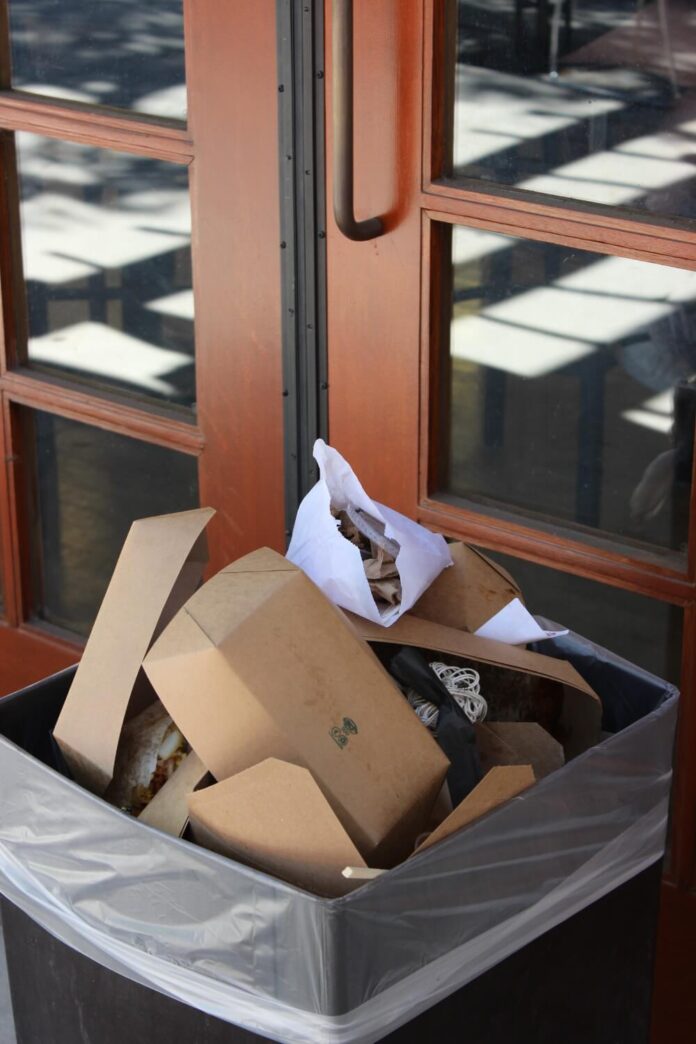
Despite the ready availability of alternatives, Occidental’s usage of single-use to-go containers has remained at alarming levels, according to Isa Merel, the Campus Dining lead intern for sustainability research and implementation. According to Merel, the college spends upwards of $44,000 per semester on single-use to-go boxes alone.
“One major shift within the last couple of years since the pandemic is that students are using the to-go boxes, even when they’re not taking their food to-go, which is new,” Merel said. “We go through over 1,000 disposable to-go boxes per day, and that’s just in the marketplace.”
These shifts can be traced back to safety measures instituted during the pandemic to protect workers against COVID-19, according to Isabelle Russell, the Food Systems Working Group co-chair and Sustainability Liaison student intern.
“Campus dining has exponentially had to increase its purchases of single use to-go boxes since 2019,” Russell said. “Part of that was because of health mandates and wanting to protect the workers. We closed our wash station or sanitation room to protect workers from COVID-19. And due to the labor issues, we couldn’t open that back up immediately last fall.”

But while COVID-19 forced Occidental to pivot to single-use to-go boxes, the emergency measures have now largely been rescinded, and the marketplace’s wash stations and sanitation rooms have been back up and running for the entirety of the semester. Still, students continue to forgo plates or eco-clamshells, which are reusable to-go containers, in favor of disposable to-go boxes, even when they are sitting in the marketplace, according to Merel.
According to Russell, the Occidental student body’s new habit is self-perpetuating.
“In my personal opinion, the to-go box has become the automatic option for a lot of students in their minds,” said Russell, “They don’t second-guess it. And I think it’s gonna take a lot of collective work to undo.”
This collective work, Russell said, will need to come from cooperation between students and faculty.
“It’s a serious issue that we really collectively need to address together, understanding the role of individuals as consumers, but also [the] systems that are in place and the role of institutions in making it easier for students to not more easily opt quickly for the single-use option,” Russell said.
Indeed, Ainsley Shelsta (first year) said she normally gets her food in a single-use container, though she said was aware of the shared responsibility for the problem. Shelsta said the other goods at the Marketplace are packaged, prompting her to get her meals to-go as well.
“It’s kind of like, ‘if I’m gonna get this to-go, why not pick up a couple other things to-go as well?’” Shelsta said. “It’s probably also just a force of habit.”
Shelsta said many, including herself, are unaware of or confused by the eco-clamshell program.
“I don’t know how it works,” Shelsta said. “I just feel like I don’t know enough about it. I don’t see a lot of people doing it.”
Nick Taylor (first year) said he also often takes his food to-go, citing the flexibility of being able to take to-go containers anywhere as an upside to using them.
“It’s more versatile,” Taylor said. “If you’re not 100 percent sure where you want to sit you could just get the to-go container and be like ‘Okay, if people are going outside then I can go outside with them.'”
Taylor also said he was not aware of the eco-clamshell program. Taylor said he is aware that to-go containers contribute to a larger ecological issue and wants to be part of the solution, but doesn’t see enough incentive.
“I realize [to-go containers] are not great,” Taylor said. “I should think about it more. I definitely should try to cut down more but, I don’t know, I feel like there’s not a whole lot of pressure at all on people to cut down.”
According to Merel, the reusable eco-clamshell to-go boxes are a sustainable alternative that retains the convenience of to-go containers. But, Merel said, the program continues to be unknown and unused by most of the Occidental student body. Merel approximated that below 2 percent of meals are served in clamshells.
“On a weekly basis, students use the eco-clamshells about 175 times total. And it’s the same students,” Merel said. “The eco-clamshell program is underused, to put it lightly.”

The eco-clamshell program, created with the intent of reducing single-use to-go container usage, provides students with a token for a one-time fee of $5 which can be exchanged for a reusable eco-clamshell container that comes with a $0.25 discount on a meal. The containers can then be rinsed and returned to regain the token.
“I understand that there are barriers as well,” Merel said. “Some of the biggest barriers that I’ve heard from students are that if you forget your token, you can’t use an eco-clamshell. Tokens are easy to lose. And then also having to bring it back afterwards is kind of a barrier to some.”
The usage of disposable to-go boxes has had a wide variety of effects from the ecological to the economic. Additionally, the overuse and frequently misclassified disposal of the single-use boxes contributes to Occidental’s carbon footprint, according to Russell. According to the dining interns’ email to the student body, this issue contributes to landfills, which are often located in lower-income communities of color.
“A lot of times I’ve even seen them in the recycling bins,” Russell said. “And that’s harmful because that just contributes to more greenhouse gases.”
What’s more, according to Russell, the increase in trash volume has put a strain on staff, who have had to increase their operations to stop the trash cans outside the marketplace from overflowing.
“We’re overburdening our facilities staff,” Russell said. “They are having to work around the clock to change out trash cans.”
Because of this, the facilities staff have to put their time and labor into an issue that is the responsibility of students and of Campus Dining, Merel said.
“We are constantly seeing the overflowing trash bins in front of the JSC [Johnson Student Center] and elsewhere around campus. But I think putting out more trash bins incentivizes more trash to be created,” Merel said.
Merel said that although the current state of sustainable usage and dining waste is daunting, effective solutions can range from the institutional to the individual.
“We have been considering changing to an all-reusable, all eco-clamshell to-go program instead of having single-use boxes,” Merel said. “[But] we’re a small school. So if even 100 more people were using their eco-clamshells that would really make a huge impact.”
Contact Henry Dorosin at dorosin@oxy.edu.
![]()


































